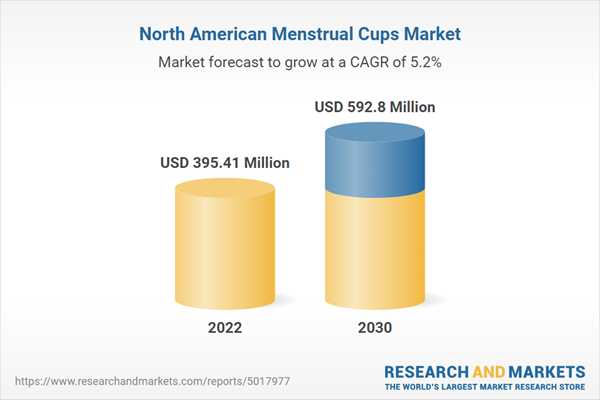Thermoplastic Elastomers Menstrual Cups Fuel North America Menstrual Cups Market
The use of thermoplastic elastomers (TPE) in manufacturing menstrual cups is emerging as a notable trend in the North America menstrual cups market. Manufacturers are increasingly choosing TPE over other materials due to its unique properties that make it well-suited for this application. TPE is a versatile material that combines the characteristics of thermoplastics and elastomers, providing flexibility, durability, and ease of processing. Its ability to be molded into various shapes and forms makes it an ideal choice for crafting menstrual cups comfortably inserted and adapted to the user's anatomy. Manufacturers opt for TPE in menstrual cup production because of its hypoallergenic and biocompatible nature. TPE is known for being safe for prolonged skin contact, making it suitable for intimate and sensitive applications like menstrual hygiene products. This characteristic is crucial for ensuring the comfort and well-being of users, reducing the risk of irritation or adverse reactions. The hypoallergenic properties of TPE enhance the overall user experience, positioning menstrual cups made from this material as a reliable and health-conscious choice in the market. TPE balances softness and firmness, providing easy insertion and removal flexibility while maintaining structural integrity during use. The material's adaptability to the body's contours enhances comfort and reduces any discomfort or pressure that users might experience with less flexible alternatives. This feature contributes to the overall positive user experience and distinguishes TPE-based menstrual cups in the market. Consumers increasingly prioritize comfort and safety in their choices, and the trend of using TPE in menstrual cup manufacturing aligns with these preferences, driving the market toward more user-friendly and health-conscious options.North America Menstrual Cups Market Overview
The surge in demand for menstrual cups in North America can be attributed to several factors that reflect changing attitudes toward menstrual hygiene products, environmental concerns, and a need for more sustainable and cost-effective alternatives. Awareness and acceptance of menstrual cups as an eco-friendly option compared to traditional disposable products such as tampons and pads is growing across the region. Menstrual cups are reusable and long-lasting, reducing the environmental effects associated with the disposal of single-use menstrual products. Single-use menstrual products and plastic packaging of pads, tampons, and panty liners generate more than 200,000 metric ton of waste annually. According to the data from the Harvard Business School, the US recorded the disposal of 12 billion pads and 7 billion tampons in landfills, sewage lines, and oceans annually. The rising focus on sustainability and environmental consciousness has prompted many individuals to seek products that align with their values. Menstrual cups, made of medical-grade silicone or other safe materials, significantly reduce the amount of waste generated from menstrual products. This resonates with consumers increasingly making choices based on environmental considerations, leading to a shift away from disposable options. Furthermore, many initiatives by the government, companies, and communities contribute to the rise in awareness of the benefits of using menstrual cups, which positively impacts the growth of the North America menstrual cups market. OrganiCup, a women-led Danish menstrual cup company, is focused on empowering menstruators and tackling this menstrual waste problem. This company is breaking barriers and generating much less waste by providing silicone menstrual cups that are reusable and available in multiple sizes. Organic cup has launched the"Campus Cup" program, an initiative to introduce their reusable menstrual cups to college-going students as a sustainable alternative to traditional menstrual products by offering them free menstrual cups. The company ran the pilot program for the students of the University of Connecticut (UConn). Additionally, the economic benefits of menstrual cups play a key role in their rising popularity. While the initial cost of a menstrual cup might be higher than disposable products, the long lifespan of the cup makes it a cost-effective choice over time. As consumers increasingly become conscious of their environmental impact and budgets, the appeal of a reusable and economical solution such as menstrual cups continue to grow, contributing to the increased product demand in North America.North America Menstrual Cups Market Segmentation
The North America menstrual cups market is categorized into type, material, distribution channel, and country.Based on type, the North America menstrual cups market is bifurcated into reusable and disposable. The reusable segment held a larger market share in 2022.
In terms of material, the North America menstrual cups market is categorized into medical grade silicon, rubber, and thermoplastic elastomer. The medical grade silicon segment held a larger market share in 2022.
By distribution channel, the North America menstrual cups market is segmented into supermarkets and hypermarkets, specialty stores, online retail, and others. The supermarkets and hypermarkets segment held the largest market share in 2022.
By country, the North America menstrual cups market is segmented into the US, Canada, and Mexico. The US dominated the North America menstrual cups market share in 2022.
Agora Brand LLC, Diva International Inc, Kay Lu LLC, Lena Cup LLC, Lune Group Oy Ltd, LYV Life Inc, Nixit Ltd, Pixie Cup LLC, Saalt LLC, and The Flex Co are among the leading companies operating in the North America menstrual cups market.
Table of Contents
Companies Mentioned
- Agora Brand LLC
- Diva International Inc
- Kay Lu LLC
- Lena Cup LLC
- Lune Group Oy Ltd
- LYV Life Inc
- Nixit Ltd
- Pixie Cup LLC
- Saalt LLC
- The Flex Co
Table Information
| Report Attribute | Details |
|---|---|
| No. of Pages | 72 |
| Published | May 2024 |
| Forecast Period | 2022 - 2030 |
| Estimated Market Value ( USD | $ 395.41 Million |
| Forecasted Market Value ( USD | $ 592.8 Million |
| Compound Annual Growth Rate | 5.2% |
| Regions Covered | North America |
| No. of Companies Mentioned | 10 |









